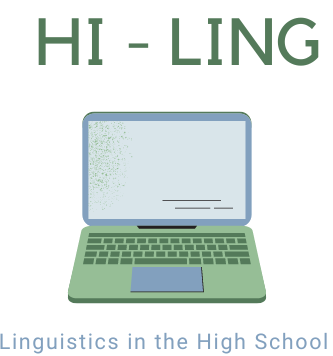HI-LING
LINGUISTICS IN THE HIGH SCHOOL

UNIT 2: VIOLATION OF MAXIMS
Lesson 2: Natural Language Processing (NLP)
Definition:
Natural language processing (NLP) is the field dedicated to developing machines capable of interacting with human language, or data resembling human language, as it is presented, expressed, and structured.
Key Concepts
-
Human language
-
Artificial intelligence (AI)
-
Machine translation
-
Sentiment analysis
-
Chatbot
-
Chat-GPT
UNIT 1: WHAT IS NLP?
What is NLP? Let’s first have a look at the terms. Do you understand all the words?
NLP is a field of artificial intelligence (AI). Machines are able to produce, organise and manipulate written and spoken language. It is based on techniques of computational linguistics using the computer to understand language and to complete different useful tasks. The two subfields of NLP are Natural Language Understanding (NLU), which focuses on the meaning of the text and Natural Language Generation (NLG), which refers to the generation of language by a machine.
Several applications of Natural Language Processing exist. We’ll have a look at them in a more detailed way after the first exercise.

Activity 1: Discussion
Your experience
Now, we will brainstorm with Mentimeter (or Kahoot): You can first discuss the following questions and then add your ideas to Mentimeter in groups of three. We will discuss your ideas in class in 5 minutes.
-
When do you use the computer for language learning?
-
What type of programs do you know/use and why?
-
What other programs cross your mind regarding language in connection with technology?
If there is more time: Another exercise with Chat-GPT, idea; ask Chat-GPT the following question: What is computational linguistics? Explain it in a simple way.
UNIT 2: APPLICATIONS OF NLP
As we noticed during the discussion, all of you frequently use NLP even unconsciously and it is used by all of us in numerous and different ways. Now we’ll have a look at the several applications of NLP that exist. In this representation, you can see some of them. Let’s have a look:
-
Machine language translation is one of its first applications that emerged in the 1950s and modernised in the 1990s with the development of new technologies. Examples of free programs are Google Translate, DeepL, and dict.leo.org. The translation does not only consist of analysing and forming sentences in different languages but also understanding the context in which the language is used. The same words can have different meanings in different sentences. Machine translation allows the service of free and instant translation but still, there are open questions about the progress of this field.
-
Smart assistant: All of you might know them. The virtual smart assistants on your phone like Siri and Alexa help us to solve tasks and answer our questions. They can be very helpful. Those spoken dialogue systems can have real conversations with someone.
-
Document analysis like the automatic correction of grammatical errors on words for example.
-
Online searches use NLP to help search engines capture both the explicit meaning of words and the underlying intent, enabling them to deliver the desired results based on our queries.
-
Predictive text: on WhatsApp for example, if you are typing a message, suggestions come up to facilitate the writing.
-
Automatic summarisation: with programs like “Resoomer” you can automatically shorten texts and generate a summary of it.
-
Social media monitoring is a technique used to observe and analyse texts, products and profiles of social media that are useful for a company.
-
Chatbots automatically generate an online conversation from two sides, for example, the online advice for online shops. With programs like chat-GPT texts can be generated online.
-
Sentiment analysis: short texts are used to represent positive, neutral, or negative emotions. Sentiment analysis is often used for customer reviews for online platforms or for detecting online comments.
-
E-Mail filtering: spam mails like publicity are detected and filtered in the spam.
-
Text-to-speech (TTS) is a technology that transforms text into spoken audio. On the other side speech-to-text (STT) converters facilitates the transcriptions of audio files. There are free programs.

Let’s do another exercise. It concerns the field of sentiment analysis. The task is to analyse, everyone on their own, the following sentences: Is the sentiment neutral, positive, or negative? You have 5 minutes to solve the task and afterwards we’ll discuss it in class.
Sentences to analyse:
-
I really loved the air b&b!
-
I am not sure if I like the new design of the website.
-
It’s easy to use this mobile app.
-
No one of the customer service could help me.
-
Excel is so confusing to me.
-
The live chat is helpful.
Activity 2: Sentiment Analysis
Analyse the statements

positive neutral positive negative negative positive
Final thought for this lesson
NLP is a large field of computational linguistics that is integrated into everyday life. The applications of NLP are wide, very useful, and simplify several tasks. A lot of research concerning NLP is done, and the field grows constantly but a lot of work needs to be done in the future.
Which of the applications of NLP do you use? Why and in which situations do you use them?
What other applications of NLP that don’t exist until now could be useful?
Sources used
TEXTS
Hirschberg, J., & Manning, C. D. (2015, July 17). Advances in natural language processing. https://nlp.stanford.edu/~manning/xyzzy/Hirschberg-Manning-Science-2015.pdf
A complete guide to natural language processing (2023, January 11).
https://www.deeplearning.ai/resources/natural-language-processing/
ILLUSTRATIONS
Datasciencedojo (September 8). Applications of natural language processing. https://datasciencedojo.com/blog/natural-language-processing-applications/#
Centric (2022, August 5). Sentiment Analysis: Way beyond polarity.
https://centricconsulting.com/blog/sentiment-analysis-way-beyond-polarity/
Dataiku (2021, February 4). Natural language processing: How it works.
https://blog.dataiku.com/natural-language-processing-how-it-works-in-plain-english